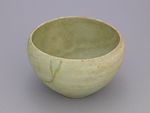Bowl
About this object
History of use
Chinese ceramics were important trade items in southeast Asia during the 11th-16th centuries and became fully integrated with ideology and ritual in Philippine societies, playing an important role in all aspects of cultural life (Langrick, p.61). Their functions were varied and included utilitarian, ceremonial and religious roles as heirlooms, and in mortuary ceremonies as burial goods and items of prestige. Chinese ceramics constitute the vast majority of burial goods excavated in the Philippines. Buried with the deceased, they acted as indicators of wealth, protected the departing spirit from evil and serving as provisions for the afterlife. Turned-over plates and bowls were used to cover certain parts of the body, establishing a protective area. In addition, many excavated ceramics were miniaturized replicas of larger, functional vessels--symbolic substitutes for provisions for the afterlife. In addition, small jarlets and bottles and other containers were used for ritual substances (oils, herbs, aromatic resins) and for food offerings necessary for the departing spirit. Most of the trade ceramics excavated in the Philippines show little or no evidence of usage before burial. The trade in Chinese celadons reached its zenith during the Song dynasty (960 - 1279) when they were traded within China and exported widely in Southeast Asia, Africa and western Asia. The trade in celadons was eventually supplanted by blue and white wares by the mid-14th century. From the condition of trade ceramics shown in published sources and the Tecson collection, it appears that most of the wares were kiln seconds, or rejects. They were nevertheless regarded with high esteem and actively traded.
Narrative
This bowl is part of a collection of Chinese ceramics found in burial context in the Philippines and was excavated in Lumban, Laguna Province, Philippines. Repairs were done by specialists employed by archaeologists and the Philippines National Museum. They were artists by training.
Cultural context
exchange; status; ceremonial; mortuary
Iconographic meaning
In many indigenous groups of the Philippines, supernatural power was attributed to Chinese ceramics because of the ringing sound emitted when lightly tapped and their vitreous, shiny glazed surfaces which impart an impermeable quality. The ringing sound was seen as a magical voice able to attract the attention of powerful ancestor spirits. Their impermeable and seemingly imperishable surfaces were believed to have great protective power against all kinds of influences, from evil spirits to poisons (Langrick, p. 55-56). To the Chinese, the subtle green of celadons symbolizes both great age and life's renewal. More importantly celadons resemble jade, which from antiquity has been considered the most precious of stones, associated with the essential elements of nature and the legitimacy of kings and emperors.
Specific techniques
According to Medley, the body material of Longquan Ware varies from a heavy, compact grey stoneware to an almost white porcelaneous material. The exposed foot burns a bright reddish brown. They were fired at temperatures between 1,180-1,280 degrees centigrade in dragon kilns - a series of about ten to twelve interconnected chambers each a step higher up on the hillside. The fire box and main stoke-hole were at the foot of the slope with additional stoke-holes at intervals up the slope on one side and peep-holes on the other side. In this way, the temperature and state of the firing could be checked at regular intervals throughout the firing period. The kilns were fired from the lowest level first with the uppermost chambers fired last and finishing last. The finest and most expensive wares usually came from the upper chambers where temperature was the most even and controlled. These dragon kilns could fire from 20,000 to 25,000 pieces in a single setting, an indication of the size of the industry.
Physical description
A deep celadon bowl with bulbous body and hole-bottom underside. The centre is slightly convex and raises to a small peak. Repairs to bowl are much more visible on the exterior surface than inside. Matte green glaze covers entire bowl except underside and a little area just above the base. Where unglazed, a reddish-brown body is revealed. A set of inked letter and number is written on the underside.
Date Made
Southern Song Dynasty (1127-1279)
Date Acquired
16 Nov 1987
How Acquired
Donated
Credit Line
Measurements
8.7 x 14.0 cm
Object Number
Ia298
